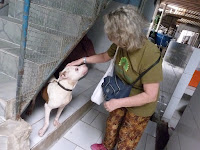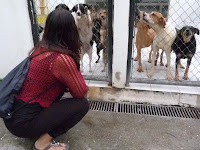I am so grateful for the help of friends who in the end of 2015 helped me organise a public yoga event in the beautiful Parque Lage in Rio to promote the work of SUIPA, one of the most popular animal shelters in Brazil http://www.suipa.org.br/index.asp?pg=suipa.htm .
The event was a total success, attracting the attention of hundreds of people and raising over £1,000 to buy provisions for 5,000 rescued animals living in the shelter. My special thanks goes to all who contributed to make this happen. http://www.suipa.org.br/index.asp?pg=clippings_detalhes.asp&id=94
SUIPA is located at the heart of the communities of Jacarezinho and Manguinhos with over 300.000 inhabitants. Apart from rescuing animals from the streets of Rio, SUIPA also offers affordable services to pet's owners who cannot afford regular vet's fees.
The atmosphere in SUIPA is vibrant and busy. At the entrance a large reception offers a waiting area to those awaiting treatment. There are many treatment rooms, collective and individual. The five thousand animals waiting adoption are kept in a vast area, clean and spacious.
Bebel, the president of SUIPA, took me on a tour to know the institution and see where the animals are kept, to meet and chat to admin staff, cleaners, carers, vets and nurses.
Everyone was so busy but also very open and welcoming. I felt very moved to see that in the offices, for instance, staff kept some 'pets' around them whilst working.
SUIPA is not only an animal shelter but the hub of a community, offering a range of subsided treatments to animals, employing dozens of people , including people on probation and doing a real service to society.
I must confess that before this visit, I assumed that SUIPA was a sad place of suffering but I have changed my mind. I was impressed to see a well organised, caring and vibrant institution, a place that not only helps animals but also connects people and communities.
SUIPA is a charity that depends on your generosity to keep rescuing animals and offering affordable services to poverty-stricken communities in Rio.
I would like to invite you to visit them or support their work either through voluntary work, donation or spreading the word. To learn more and make a difference please click on http://www.suipa.org.br/index.asp?pg=comoajudar.htm .
Thank you very much.
Om shanti, peace and light.
Thereza
https://www.facebook.com/LightAndExpansionYoga/
I would like to invite you to visit them or support their work either through voluntary work, donation or spreading the word. To learn more and make a difference please click on http://www.suipa.org.br/index.asp?pg=comoajudar.htm .
Thank you very much.
Om shanti, peace and light.
Thereza
https://www.facebook.com/LightAndExpansionYoga/






















.jpg)
